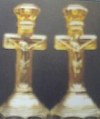Imperial Heavy Grape
Imperial Heavy Grape
A study in newly found pattern variations
By Steven Fink
A background on Imperial Heavy Grape
One of Imperials more prolific patterns was what we have grown to know as Heavy Grape. Production of this pattern, according to Butler Bros ads, dates from around 1911 thru about 1929, a very long run for this pattern. Consisting of a large cluster of grapes centered in the pattern, over the top of a leaf arrangement, with stippling covering the rest of the center of the pattern. From there, a quilting effect extends to the outer edge. The back pattern consists of one of Imperial’s Flute patterns, what they called #700 in old catalogs, usually fairly pronounced. The base, or marie, has a rayed star on it. All pieces have a collar base. Shapes include bowls, plates, nappies, and an impressive punch bowl which very seldom comes up for sale.
The 8 ½-9” bowls, both round; usually called a master berry, and ruffled; usually fairly deep, but some flaring out into the 10 in. range. Marigold pieces in this size abound, Purple examples are popular, with some being spectacular. Green pieces can also be found readily, with excellent Smoke, Clambroth, and Amber examples also out there, but can be found with not too much trouble. Teal pieces are also known, but harder to come by. From this mold also came the spectacular 10” chop plates. The next smaller mold size seems to be the most common size found; with pieces showing up everywhere from garage sales to Antique malls and even major auctions. These pieces consist of 6 ½-7” bowls, either round or ruffled. All the colors found in the larger sized pieces are also found in this size; but also includes Lime, Vaseline, Powder Blue, and Blue, the latter being very rare. To this date, there are about 8 known pieces in Blue. An even smaller mold was used for making the sauces or small berry bowls, depending on whether they were ruffled or left round. The usual Imperial colors prevail, with sizes staying around 5” for both round and ruffled pieces. A few rare 6” Marigold plates are known from this size mold. Imperial also made a one-handled nappy in the usual Imperial colors in this pattern, with a few Blue examples known. Purple examples in this shape can be outstanding. Seldom seen Punch Bowls exist, with Marigold seen most. The punch cups have a ground base; with the purple ones being most popular, as purple usually is with most Imperial patterns.
And now, the Find.....
My wife and I started collecting the mid-size pieces, 6-7” bowls and plates, acquiring prime examples of each color, which is relatively easy to do. Then on March 17th of 2004, something happened that made me look differently at this common pattern. I was browsing an antique mall in Springfield, OH when I came upon two dark looking Imperial Heavy Grape bowls in a booth. Both 6 ½” across, round in shape, both with nice color. Something seemed strange about how they looked and called the key-keeper over to take a closer look. And was I glad I did! It turned out that both bowls were BLUE!!! I hurriedly walked the pieces to the counter and paid for them, barely keeping the smirk off my face, which usually comes shortly after making such a find. I had achieved what we all want to do, found rare glass for very little money.
Getting the pieces home and finally being able to clean them properly was a great feeling. When I placed them next to our other Heavy Pieces of the same size, or should I say, from the same size mold, there was an obvious, noticeable difference. The multipoint star was absent from the base. It was smooth, and slightly concave. But without question, an old piece. After consulting with others, and in particular Dean and Diane Fry, about the lack of a starred marie, I noticed something else different. A smaller grape cluster, 29 on my Blue piece compared to 37 on the ‘ normal ‘ pieces, and the leaf arrangement were also slightly different. Between the ruffled and round bowls, and the 8” plates, we have all the colors of the Heavy Grape pattern in this mold size. Not previously noticing this difference, we didn't think to look if any of the others had this same base treatment.
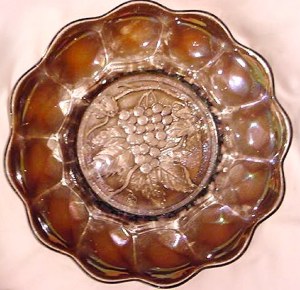 |
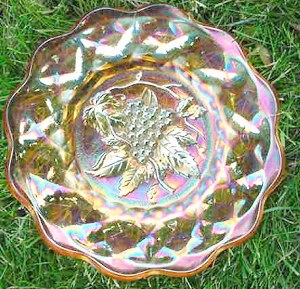 |
The face of Steve's Smoke HEAVY Grape plate-plain marie
|
Marigold HEAVY GRAPE 8 in. plate with plain marie
|
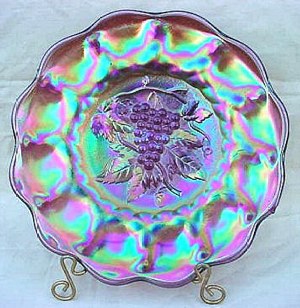 |
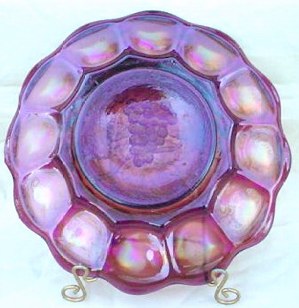 |
The face of Steve Fink's plate having the plain marie.
|
Steve Fink has found an amethyst 8 inch plate with the same plain base as the blue bowls, which he is responsible for locating, as well.
|
Upon closer inspection, we noticed the Smoke 8” plate we acquired at the auction of Dr. Jack Adams in November of 2003, also lacked a starred marie. Since then, I've managed to acquire a Marigold and an Amethyst 8” plate, and received a photo of a Green 8” plate from a very nice lady via the www.cga website. I have also located and got positive ID on a 6 ½” Marigold round bowl. The owner wouldn't part with it, but supplied a very nice photo of it. Found too was a 5 3/4" round Marigold bowl in Australia, which I'm hoping to acquire. I have so far verified 9 pieces with this ‘star-less’ marie treatment and am continuing to hunt for more examples. All of these pieces mentioned also have 29 grapes in the cluster.
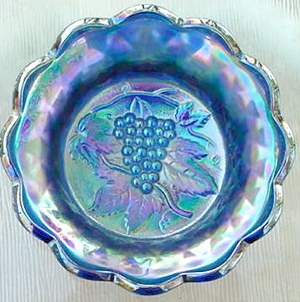 |
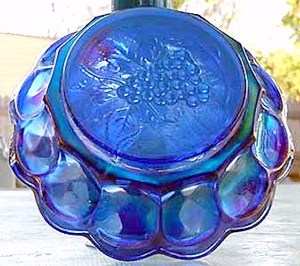 |
There is a difference in the grape cluster!
|
HEAVY GRAPE plain marie
|
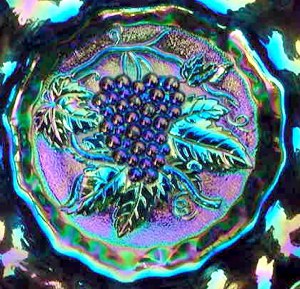 |
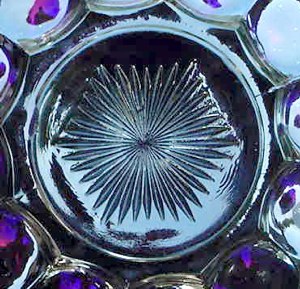 |
You can count the grapes for yourself!
|
This is the usual design found in the marie of HEAVY GRAPE pieces.
|
Now the question is…
‘Is this enough of a difference to name these a variant?
The grape cluster on these Heavy Grape bowls is without question different, putting the Blue one I found with the 29 grape count next to a ‘normal’ piece with 37 grapes, shows this difference easily. And with closer inspection, the differences in the leaf arrangement can also be seen. The quilted interior seems to be the same, and the exterior Flute pattern also seems to be consistent with ‘ normal’ pieces. Setting any of our plain marie pieces along side a regular one and both of these differences can be readily found without much effort. Would this ease of finding a difference in patterns help determine whether or not the dreaded ‘variant’ term is applied? This lack of a starred marie so far has only showed up on the mid-size, 6-7” pieces. So, is this difference enough to warrant that denotation, or is this just a case of old molds wearing out and newer molds, albeit slightly different, being used in their stead? Maintaining the molds during this process alone would warrant new ones being made, as they were scraped to remove excess glass from a previous firing, eventually making the mold lose more crispness and detail of the pattern. Causing its demise in the end. Considering the vast quantities made and the length of time this pattern was produced, it would seem obvious that many new molds would have been made. And with different people doing this, certainly not every one of them would have been exactly the same. But if this were the case, more of these pieces should surface. Another question would be, why haven't more Heavy Grape pieces with this slightly different interior pattern surfaced? Or should I say, more than one difference. Unless molds themselves had patterns followed when being made. And what about the plain maries? Perhaps a mistake made by an inexperienced worker inserting the wrong piece into the mold, the plain marie instead of the usual starred one. One can wonder how many of these pieces were produced before this different marie piece was noticed. One could make a case of not using the starred marie piece of the mold to reduce cost for a private limited production. Could whimsey be a more appropriate description? Or maybe it was an error? Further investigation will expose more of these types of examples, and with more known, we can expand our knowledge.
Comparing some patterns with an already accepted variant
I now refer you to the Millersburg Peacock and Urn Variant small bowl. It was probably made to replace an older mold, but had a slightly different pattern than the older ones, perhaps made by someone else other than the original mold maker. If this was a mold used for everyday production, shouldn't it just be considered part of the regular Peacock and Urn line? Given Millersburg’s relatively short life-span, it could also have been made for a trial run, which would explain the relatively few pieces known. One could make a similar argument for these Imperial Heavy Grape bowls with the aforementioned differences. Fenton's Vintage pattern has similar pieces with differences depending on the age of the mold used, but are not referred to as a variant. Northwood’s Grape and Cable bowls and plates have pattern variances in several different sizes. Yet only the 8 ½” bowls and the 9” plates are termed variant. And Northwood found a way to extend the life of their molds by adding stippling. Imperial has a few variants, which mostly consist of an interior ribbing on some pitchers and tumblers. Some Northwood tumblers are also given this variant designation by virtue of this same interior ribbing. Not really that much of a difference, given that these were also perhaps production molds with the wrong interior plunger used. A number of variants consist of similar pattern made by different companies, Cosmos Vt and Vintage Vt, both Dugan products come to mind. Another Dugan pattern, Garden Path, has a variant by virtue of adding a bit more to the outer edge of the pattern. With all this in mind, where do we put these different Imperial Heavy Grape bowls?
And in conclusion
So, who has the final say on whether differences in a pattern warrant a variant designation? We, the collectors do. I am not trying in any way to convince anyone that the differences in these Heavy Grape bowls stated before in this pattern constitute this a variant. I am merely explaining those differences in this and other patterns for comparison. As more of these examples of Imperial Heavy Grape with the plain marie and different interior pattern surface, perhaps we will learn more of their origin. If anybody has more information, or has pieces with these same qualities, please E-mail Me so I may add that information to my findings.
Steve Fink - 09/05

Should you care to contact the Frys, their email address is:
Search Our Sites
back to Carnival Glass 101
Our other sites you may enjoy:
Everything you EVER wanted to know about Indiana Glass
Great Reference for Newer Carnival Glass.
Complete Glassware Catalogs Available to Download
Questions? Comments? Suggestions? Broken Links? Corrections?
Your Friendly Webmaster is here to help!
